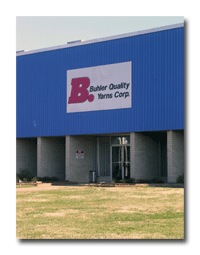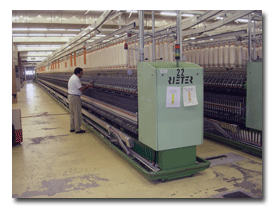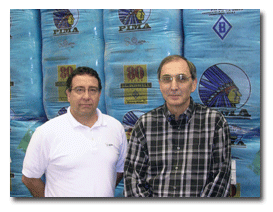T
his past year didn’t turn out all that badly. And assuming the absence of any big new
domestic or international surprises, a similar reassuring pattern would seem to be shaping up for
the next 12 months.
This optimism is based on more than just wishful thinking. True, both the textile and apparel
industries may be in for a bit more shrinkage. But by and large, all signs suggest both sectors
will survive as they become increasingly efficient and a lot more internationally oriented.
To be sure, plenty of problems remain. Specifically, the multitude of serious challenges the
industry has been facing for years — still-rising import levels, changing international ground
rules, cutthroat competition and ever-changing consumer wants — will persist. But overall, most
mills should manage to keep their heads above water. Indeed, for those who play their cards right,
some selective production and profit gains may even be attainable.

The China Question
The one biggest imponderable, of
course, remains China — and more specifically, just how much more Beijing import penetration can be
expected for 2007 and beyond. As for now, however,
Textile World
remains basically confident that any further trade advances by that nation will be in the
tolerable range.
One factor behind this basically positive assessment: the changed makeup of the new US
Congress. Other things being equal, Washington lawmakers are likely to be a lot more aggressive in
their efforts to protect our domestic textile and apparel interests. This kind of proactive
approach could well convince Beijing to slowly raise the value of its badly undervalued yuan, as
well as end some of that nation’s unfair subsidies to its producers.
In any event, odds favor some gradual shrinkage in today’s huge Chinese textile and apparel
price advantage — if not this year, then certainly by 2008.
US Mills Invest For The Future
There are other factors, too, that
should keep US mills viable in today’s volatile one-world market. One of these is continuing
capital investment. Recent numbers released by the Washington-based National Council of Textile
Organizations (NCTO), for example, show plant and equipment spending by the industry came to more
than $33 billion over the past decade. If nothing else, outlays of this magnitude can’t help but
improve industry productivity — and in the process help keep labor costs under control. But more
than that, these huge expanding expenditures can also enhance mill flexibility, speeding up the US
domestic firms’ response to demand shifts; establish a firm base for the development of new and
improved fibers, fabrics and garments; and help the industry come up with more niche products — the
kind that generally carry a lot higher profit margins.
Moreover, add in such other pluses as increasingly savvy management approaches — including
more vertical integration and growing international contractual moves involving outsourcing and
joint ventures — and the future doesn’t look all that bleak. Indeed, all of the above developments
would seem to assure that US mills and clothing manufacturers will remain in the top tier of
world-class suppliers over the longer pull.
Indeed, there is already some solid evidence that all these strategies are paying off. Thus,
this past year’s combined shipments of basic textiles, textile mill products and clothing added up
to nearly $108 billion. That’s only a miniscule $1 billion or about 1 percent under the previous
year’s aggregate figure — and nowhere near the declines that many had been predicting.
Finally, a vibrant economy also has to be factored into this basically positive industry
appraisal. Our gross domestic product (GDP), for instance, is expected to show another 2.5- to
3-percent advance in 2007 — with equally rosy figures anticipated for both 2008 and 2009. This
alone would seem to assure continuing gains in domestic purchases of apparel, home furnishings and
other textile products.
Meantime, zeroing in on the new year,
here’s how
TW
editors see key elements of the industry shaping up:
Demand: While overall domestic activity should continue to edge lower, the drop
again will be quite small. Looking at textile mill shipments, first
TW
equations suggest only a 1- to 2-percent decline. As in 2006, virtually all of the
slippage will be centered in basic textiles — fibers, yarns and fabrics. On the other hand, more
highly fabricated textile mill products — home furnishings, rugs/carpets and industrial products,
for example — will hold pretty much near 2006 levels, although some decline can’t be ruled out in
carpets as housing construction takes a bit of a breather.
But even with some overall slippage, these domestic rug and carpet shipments should manage
to reach close to $13.5 billion. That’s not bad considering the fact that a decade ago, these
shipments were running only around the $10 billion mark.
The overall textile industry should also be helped by another tolerably good apparel buying
year in 2007. Thus, projected domestic clothing shipments — while not expected to grow as they did
this past year — should pretty much hold their own. But, on a somewhat more sobering note, it
should be recognized that the US apparel industry, while still accounting for nearly $36 billion
worth of shipments, is nowhere near the $60 billion-plus levels of a decade ago.
Supply: Excess rather than shortages should pretty much remain the order of the
day as US mill operating rates remain relatively low, and overseas producers — hungry as ever for
US dollars — continue to expand their push into our domestic markets.
Looking at US production potential first, the aggregate mill operating rate — production as
a percentage of rated capacity — is expected to remain in the low 75-percent-plus range. That’s a
far cry from the near-90-percent peak hit back in the mid-1990s. To be sure, mill closings will
continue as companies are forced to abandon inefficient facilities. But much of this already has
been accomplished. Equally important, the pressure to remain competitive should result in new
capacity increases as mills continue to pour money into new and more efficient facilities and
processes. Bottom line: This additional investment should offset further plant shutdowns — making
it increasingly difficult, if not impossible, to raise the industry operating rate to any
significant extent.
Nor are today’s relatively low inventory levels expected to create any supply problems. The
fact is that our domestic mills have vastly improved their forecasting expertise, their logistics
and their ability to react quickly to any sudden change in demand. Implication: There’s no need to
expand inventory levels, even in the face of increasing consumer buying volatility. Upshot:
Continuing low inventory/sales ratios are nevertheless substantial enough to avoid any serious
stockouts.
Prices: Here, too, recent developments have turned out better than expected.
Rather than fall, as many had predicted, both basic textiles and textile mill product quotes have
continued to hold their own — and in some instances have actually managed to creep up a bit.
Carpets and rugs have been among the positive performers. Bureau of Labor Statistics price
data here, for instance, show a solid 2-percent advance over the past 12 months. On the other hand,
this uptrend could be about to flatten out as reduced 2007 housing activity puts a crimp in this
subsector’s demand.
Greige goods have been even better price performers over the past year — with average quotes
here advancing about 3 to 4 percent, and
TW
sees another small increase for the new year.
The picture is much the same for both finished fabrics and industrial textiles. Both these
sectors managed to rise a few percentage points in 2006 — with further fractional advances seen for
the next 12 months.
To be sure, there have been some exceptions to this basically firm price picture. Thus, both
home furnishings and apparel have not been all that buoyant as strong competition virtually rules
out any meaningful gains. The fact is that both of these sectors have been severely impacted by
low-priced imports to the point that price averages have been hard-pressed to even maintain the
previous year’s level. Indeed, if you zero in on some apparel products like men’s suits, sport
coats and outerwear, some sizeable year-to-year declines become readily apparent.
The apparel softness is actually part of a long-term trend, with prices here backing and
filling around a small 1- to 2-percent range for more than a decade now. And there’s little to
suggest any 2007 change — at least not as far as the overall apparel price average is concerned.
Costs: As noted earlier, no problems are anticipated in payroll outlays. And in
the case of the other major expenditure stream — fibers — all signs point to no major changes in
either natural or man-made constructions.
Looking at cotton first, while there will be some decline in US crops during the current
marketing year, this should be more than made up by increases in other big cotton-growing
countries, such as China, India and Pakistan. Therefore,
TW
looks for about a 2-percent increase in the global crop — more than sufficient to satisfy
projected demand. This, in turn, points to little major change in cotton prices. Domestic tags in
2007 should remain in the recent 45 to 50 cents-per-pound range — marking the second straight year
of basically unchanged quotes.
The cost outlook for man-made fibers also is reassuring. To be sure, averages here are up
about 3 percent from a year ago. But with their key feedstock — petroleum — down significantly, and
manufacturing capacity both here and abroad more than adequate, it’s hard to see any meaningful
upward drift.
Meantime, some further comment on labor costs would also seen to be in order. Here again,
there are moderating factors: expectations of another moderate pay hike in 2007; and continuing
productivity gains, which should offset the wage increase. Put another way: Unit labor costs will
in all likelihood remain unchanged.
Actually, this encouraging unit-labor-cost trend has been going on for years now. Compare
2003 with 2006, for example, and you find average textile industry productivity rising by slightly
more than 3 percent per year, while annual labor rates have edged up slightly less than this 3
percent. Implication: steady to maybe even fractionally lower unit labor costs over the past three
year.
Profits: Put such factors as these relatively stable costs, slightly higher
industry prices, and only a small drop in production into the computer hopper, and you end up with
a really not-all-that-bad earnings level. Indeed, both after-tax profits and after-tax profits per
dollar of sales managed to eke out small gains last year. On the net profit front, for example, the
domestic industry total came to nearly $1.72 billion — considerably above the previous year’s $1.5
billion figure and the highest level since 1998. More significantly, those latest numbers are a lot
better than the near-zero-to-actually-negative figure that was reported as recently as 2000 and
2001.
It’s also interesting to point out that this past year’s profit performance wasn’t all that
different from earnings reported by most other industries. More to the point: The 10-percent
increase in textile mill after-tax profit in 2006 compares quite favorably to the all-US-industry
8-percent increase.
Employment: There seems to be no way to stem the inexorable decline in the nation’s
textile and apparel workforces. In part, this can be traced back to the continuing productivity
gains. Employment totals would continue to shrink even if the industry were able to maintain a
steady production volume.
But that’s an unrealistic “even if,” as domestic mill activity — plagued by ever-rising
imports — continues to shrink every year. Not surprisingly then, 2007 worker totals will continue
to show significant slippage. Hence, these projected worker attrition rates for the new year: 5
percent in the already hard-hit basic mill area, 6 percent in apparel, and perhaps 1 percent in the
somewhat firmer fabricated textile product sphere. However, even with this erosion, the domestic
textile/apparel complex should still play a significant role in overall US industrial activity.
Indeed, according to NCTO, this overall sector — including some supporting industries — is still
providing jobs for close to a million domestic workers. Equally significantly, our mills and
factories are also managing to contribute an important $60 billion to the nation’s GDP.
Trade: Incoming shipments from abroad have turned out to be somewhat less
disastrous than many had predicted. True, imports of textile and apparel products were up again
last year. But the gain was fairly subdued — something in the order of 3 percent on a square meter
equivalents (SME) basis — and well under the nearly 11-percent advance of the previous year.
Also noteworthy here, Chinese increases seem to be slowing down a bit — with preliminary
estimates for 2006 putting that Far Eastern nation’s gain at around 9 percent, far under the close
to 44-percent jump recorded just one year earlier. Unfortunately, some of this deceleration was
offset by larger gains from other nations like Taiwan and South Korea.
As for 2007,
TW
equations suggest another relatively small advance in overall incoming shipments —
probably something again in the order of 3 to 4 percent. And while the biggest chunk of these
shipments — about 40 percent — will still be from China, substantial volume is also seen for other
Southeast Asian nations, the Association of Southeast Asian Nations (ASEAN) bloc and our nearby
neighbors such as Mexico, Canada and Caribbean Basin nations. Again, while the increase is better
than in some earlier years, this still points to an import total of more than 54 billion SMEs —
nearly twice the volume of incoming shipments reported as recently as 1999.
On a somewhat rosier note, US textile exports should also continue to move higher. They
should offer both a modest offset to the import surge, and help maintain the US position as the
third-largest exporter of textile products in the world. But even with an export counterweight, the
US textile and apparel trade deficit would continue to grow.
TW
’s best estimate here: About an $83 billion red-ink figure for 2007 — that’s close to
60-percent above the trade shortfall prevailing back in 1999.
Coming back to the Chinese problem:
Pinpointing future developments will remain quite iffy given the number of questions that remain
unanswered. The biggest of these, of course, is how Beijing’s currency, the yuan, will fare
vis-à-vis the US dollar. With the yuan already up close to 6 percent over the past 18 months, some
further upward moves are indeed likely. But just how significant they’ll be is still anybody’s
guess.
One thing is for sure: Virtually no one denies further adjustments are necessary to slow
down Chinese exports. Other things being equal, further upward revaluation would make Chinese
products more costly in terms of the dollar. They could also help narrow the trade imbalance in
still another way — by making US exports to China a little more affordable to their producers. In
any event, it’s becoming increasingly clear the status quo is no longer an option. And that goes
for Europe as well, where a similar trade deficit with Beijing has become unsustainable.
If there is any doubt these trade imbalances need to be taken seriously, just look at the
latest numbers, which put the Chinese global trade surplus at well over $200 billion. This, as
might be expected, has pushed Beijing’s foreign exchange reserves to record levels.
How much upward revision then should be sought? The percentage depends on whom you speak to.
Two US Senators, Charles E. Schumer, D-N.Y, and Lindsey Graham, R-S.C., give a range putting the
unfair advantage of the currently undervalued yuan at anywhere from 15 percent to 40 percent.
On a more positive note, however, there also are other factors at work that could slow down
Chinese import gains. One is growing pressure on the part of the United States and other
industrialized nations to reduce Beijing’s internal subsidies to its own domestic producers. If the
drive is successful, it could make for a big impact. That’s because Chinese producers now benefit
from a spate of hidden deals — generally in the form of research and development subsidies, cheap
or free loans, free land and tax holidays.
Still another possible import brake could come from that nation’s gradually increasing raw
material and labor costs. On the latter score, the Chinese minimum wage in some manufacturing
centers was recently boosted by as much as 20 percent.
Reflecting on all this, some Chinese producers report shrinking profit margins. And as a
result, they are moving to ease the pressure by increasing prices by as much as 5 percent when
renewing existing contracts. Still another trend development that might slow down the Chinese
import wave: Some shifting of business on the part of US buyers to other low-wage nations like
Bangladesh and Turkey. Finally, as noted earlier, there is likely to be some impact from the
post-election makeup of Congress, which suggests that if the trade situation continues to
deteriorate, there could well be more pressure for legislation targeting everything from illegal
subsidies to currency-manipulation schemes.
In any event, with China now accounting for close to one-quarter of the total US trade
deficit, that country is certain to be a big issue for trade skeptics in the new Congress.
American executives agree. As Auggie Tantillo, executive director of the Washington-based
American Manufacturing Trade Action Coalition, recently put it, “there is going to be much more
significant oversight and scrutiny.” To which Cass Johnson, president, NCTO, added, “The trade
agenda is continuing to shift toward an anti-free-trade stance.”
But some observers aren’t sure this is the answer, noting that anti-Chinese moves could be
counterproductive. They say forcing a much higher yuan would lower the prices of incoming Chinese
raw materials, and in the process make it actually easier for that nation’s producers to hold the
line on prices.
Finally, some analysts feel the curtailing of more and more imports from China wouldn’t
provide any final answer to our trade problem either. That’s because any such move would
precipitate the importation of similar products from other Third World countries.
Meantime, domestic firms continue to
make impressive progress in their basic strategy to whet consumer appetites with a host of new and
better performing products. This is certainly the case in the fiber sector, where a growing number
of enticing new introductions are constantly hitting the market.
Nor are these changes limited to newly designed man-mades. Thus, even the old standby
natural fibers — cotton and wool — now are regularly coming up with new offerings.
In cotton, for example, a new technology dubbed Endure™ and aimed at home textile products,
presents users with a finish that significantly increases product durability and the wear life of
sheets. And it does so without giving up such other attributes as soft hand, easy care and comfort.
It’s similar to a finish already available on many apparel lines.
Other recent improvements in the fiber, adds Cary, N.C.-based Cotton Incorporated, include:
an activewear finishing process that transports moisture to the fabric surface where it spreads out
and quickly evaporates; and a new water-repellent treatment that is applied to finished garments.
Wool isn’t being ignored either — with the industry now offering a new non-scratch variation
called “Cashwool” that is said to be a lot more comfortable when next to skin.
Also — while on the subject of wool — it should be noted that Congress is working on
legislation to protect consumers against false labeling. By closing loopholes that permit the
mismarking of suits and separates, it would ensure that buyers get what they are paying for.
Another significant fiber trend: The accelerating move toward the production of more
eco-friendly clothing. Helping this along is the fact that organic cotton is now a lot more
available and of much better quality than it was a decade or so ago.
Not surprisingly, big clothing firms like Levi Strauss are jumping on the ecology bandwagon.
The company says it will now be making jeans with organic cotton as well as other environmentally
correct materials such as recycled metal and natural wood buttons.
Nor is cotton alone when it comes to being eco-friendly. Thus, fleece made from recycled
plastic soda bottles is now also readily available. And in another development, Tencel® — a
man-made fiber made using cellulosics found in woodpulp — can now be found in everything from
dresses to pajamas.
It all makes a lot of sense, according to market researchers. Indeed, one recent sports
apparel preference study conducted by Greensboro, N.C.-based Unifi Inc. reports 42 percent of
respondents now say they are likely to buy eco-friendly products.
Taking off on this, Unifi says it has high expectations for its new Repreve® yarn made from
100-percent recycled polyester. It’s designed to cover a wide range of applications including
moisture management, stain release, ultraviolet protection, odor control and stretch.
To be sure, going eco-friendly does have some pitfalls. Thus, some natural fabrics, such as
those made from corn, can’t survive hot irons. Others, like bamboo, don’t take abrasion well and
can stretch out. And banana fiber works well for hats but is itchy when used in clothing.
A few words are also in order on nanotechnology, another rapidly growing area. Nano products
have gained surprisingly wide consumer acceptance in a very short period of time. And for good
reason: In addition to superior appearance, nano products have many other impressive attributes
including reduction of additive use, thus lowering costs; antimicrobial protection and flame
retardancy; and improved functionality through stain resistance. Still another plus: The nano
approach has a minimal impact on material properties.
Not surprisingly, the garment and
home furnishings industries continue to take advantage of all the new fiber developments — and in
the process are providing consumers with a host of attractive, better performing products.
In the bed and bath area, for instance,
TW
has already referred to improved sheet fabrics. And to this should be added new towels
made from a blend of bamboo and cotton, and said to be 25-percent softer after laundering than
their all-cotton counterparts.
Looking at apparel next — even the lowly sock is dipping its toe into new technology. Dress
socks are now available that provide moisture wicking, storing and releasing of body heat and
destruction of odor-causing bacteria.
Shifting attention to men’s shirts, there are new fabrics designed to keep in heat or let it
out as needed. And as an added plus, they are also infused with silver particles to resist odors.
Men’s suits are also undergoing major changes, with some new constructions made from
wool/polyester blends that can be washed, machine dried and worn without ironing. While hardly
upscale, they’re a heck of a lot better than earlier wash-and-wear versions that never really
caught on.
Meantime, more and more outerwear manufacturers are coming up with new water-repellent
finishes for cotton fabrics that are said to beat the best competing man-mades in such attributes
as breathability and durability.
Jean improvements are also making news. For one, there’s the trend toward eco-friendly
denims noted earlier. Also on the jean front, there is a lot more emphasis on premium grades that
sell for less than $100 — half of the recent tab — as lower-priced denim fabric enters the market.
This upgrading trend has even spread into such traditional standbys as corduroy. More
expensive offerings here include new blends like cotton/cashmere, cotton/merino wool and
cotton/silk.
Moving into the more esoteric, there is the Netherlands-based Philips’ new Lumalive system
whereby swaths of fabrics can be turned into glowing multicolored panels able to display
characteristics or simple animation. Commercial production here is scheduled to begin sometime this
year.
Finally, don’t forget continuing progress in both the nonwoven and medical areas, with both
these high-margin sectors continuing to attract attention. In the medical sphere, for example,
applications continue to be found for a host of health-promoting and even life-saving applications.
Consumers are probably most familiar with the patches and pads found in drug stores. But
they also are benefiting from new state-of-the-art high-tech fibers used in such complex medical
procedures as vascular grafts, hernia repair and stents.
With all of the above, it’s becoming
increasingly clear that our multi-faceted textile and apparel complex isn’t about to disappear. On
the other hand, all the recent progress doesn’t in itself assure continuing success. Vigilance will
still be the order of the day as more and more challenges appear that will require the continued
fine-tuning of the industry.
For one, increased consolidation, integration and emphasis on a single global marketplace
all underscore the need for even better monitoring of company logistics. In fact, this is probably
the key reason behind the growth of global logistics firms — outfits whose sole purpose is to set
up procedures to assure the meeting and demand of production schedules at the lowest possible cost,
and the keeping of inventories as lean as possible.
As one logistics company spokesman recently put it: “The smart companies that will be the
eventual winners are those who look beyond the transactional and into the strategic. They link
themselves together with their vendors and logistics suppliers to avoid costly duplication, and
take costs out of the system while accelerating their merchandise through the chain.”
Another important “must” these days: The need to keep on innovating — maintaining the
ability to come up with still newer and better products. And this is far from being an easy task,
for it has to involve virtually every facet of textile/apparel activity — including production,
processing, logistics, market strategy, brand management and the meeting of customer needs.
If there is any doubt on the need for continuing industry innovation, just take a look at
some of the big names in textiles that have been embracing the concept. A Spartanburg, S.C.-based
Milliken & Company executive typifies the thinking here: “We will continue to have a mix of
both commodity and technical. But we’re doing more research and adding more value to our products
because that’s the way the market is going.”
This kind of approach, in turn, is necessitating many more market studies. One example: the
decision on the part of some apparel firms, after intensive study, to develop sizing systems that
represent the three most common female figures. The goal: Production of the three versions of every
female size — one for each body shape.
The recent introduction of more durable bed sheets is also the result of an industry-wide
attempt to satisfy the ultimate consumer. Specifically, it reflects the results of a study showing
that product durability outweighed price when deciding among various sheet alternatives.
In short, today’s market strategy has become quite clear: Find out what John Q. Public
wants; make it; and, in the process, also come up with improved pricing and profits.
In any event, all this bodes well for the survival and even prosperity of this challenged
industry. One hint of what should be in store for textile and apparel makers over the next few
years comes from the latest longer-term projections released by Global Insight.
Looking first at the bottom line, this Boston-based economic forecasting firm’s analysts —
using their own definition of profits — gross revenues less labor and material costs — agree with
TW
that any shrinkage will be quite modest over the 2006-2009 period. Indeed, for basic mill
items, the firm projects little or no change in earnings over this three-year span.
And the picture isn’t all that bad for more highly fabricated textile mill products. Here,
their profit figures fall from the past year’s relatively high $11 billion level to a
still-respectable $9.5 billion in 2009.
Global Insight justifies these numbers on the belief that any decline in shipment volume
over this period will be relatively small — plus the fact that there will be little or no advance
in unit production costs over the period.
One top mill executive sums it all up: “We’ve got our eyes on more than just what’s
happening today. We’re in this for the long haul.” Moreover, add in what’s being planned to what’s
already on the drawing boards, and the American textile industry should not only continue to
survive, but also prosper.
January/February 2007









